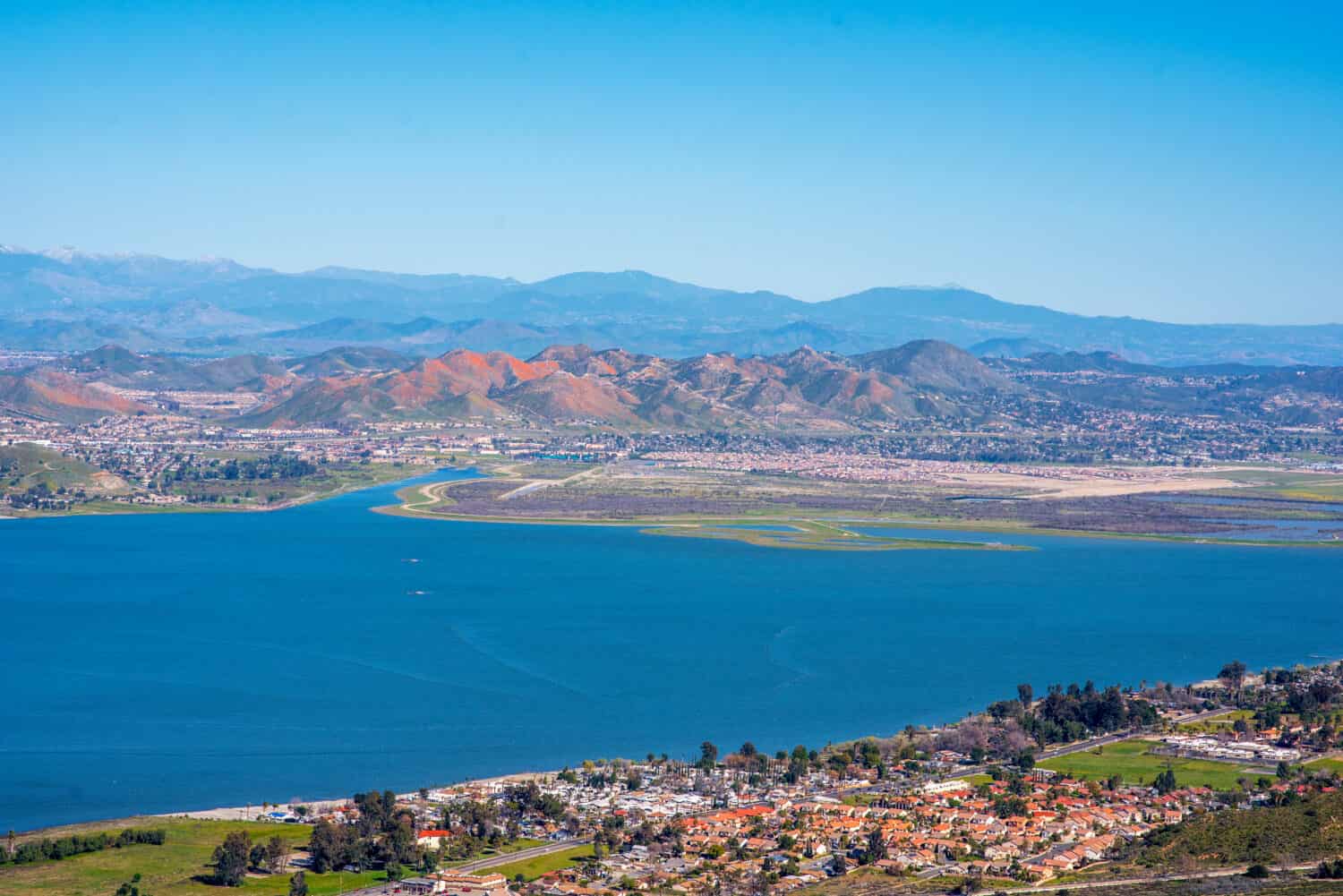Lake Elsinore is the largest natural freshwater lake in Southern California. It features 14 miles of shoreline and 3,000 surface acres of water in the middle of the city of the same name. In the early 1800s, the lake was little more than a swamp, before growing in size and providing a campground and watering hole for trappers and rancheros. Today, it provides recreation for the people of California and visitors in the form of boating, water sports, fishing, swimming, and wildlife viewing. Discover all there is to know about Lake Elsinore, including its location, history, size, recreational activities, and wildlife.
Lake Elsinore Location

Beautiful Lake Elsinore is the largest natural freshwater lake in Southern California.
©iStock.com/Cavan Images
Lake Elsinore lies at the lowest point in the San Jacinto River watershed and is the terminal lake of the San Jacinto Basin. The lake is in Riverside County in Southern California, south of Anaheim and Riverside but north of San Diego. It’s east of the Santa Ana Mountains, which is a short range along the Southern California coast. Lake Elsinore is fed by the San Jacinto River, and its outflow eventually finds its way to the Santa Ana River. But before that, the lake’s northeastern shore spills into the outflow channel, flowing through the Temescal Canyon and feeding the Alberhill Creek. The Alberhill Creek eventually joins the Temescal Creek, which feeds the Santa Ana River.
Lake Elsinore History
Juan Santiago, the Spanish explorer, laid eyes on the lake back in 1797 and named it Laguna Grande. A bit over a decade later, a traveler described the water as little more than a swamp. But the lake grew larger by the 19th century, when immigrants, rancheros, and trappers used the water as a haven for their campsites. Eventually, the lake’s southern shore became the Southern Emigrant Trail, a major route for people immigrating into California from the eastern side of the country. Lake Elsinore was renamed in 1888 for the town of Elsinore. Over the decades, Lake Elsinore has gone through many periods of flooding and drought, with some overflowing water even destroying homes and businesses nearby. However, there have since been measures put into place to keep the water’s level more consistent.
Size, Depth, and Water Level
Lake Elsinore is 3,000 surface acres with an elevation of 1,255 feet. The lake features 14 miles of shoreline and a max width of 1.5 miles. It has an average depth of 27 feet and a max depth of 42 feet. And it is the largest natural freshwater lake in Southern California.
Lake Elsinore has an optimal water level of around 1,240 feet, and it is currently at an average of 1,244 feet. While the lake sees some fluctuation, measures put in place have drastically reduced the probability of flooding and drought.

Lake Elsinore features many recreational activities, such as boating, water skiing, swimming, and fishing.
©Marie1969/Shutterstock.com
Fishing, Boating, and Other Activities
Lake Elsinore is a haven for recreation, such as boating, jet skiing, water skiing, fishing, wakeboarding, swimming, kayaking, picnicking, nature viewing, and bird watching. There are several swimming beaches perfect for you to spread out a blanket and some chairs. But check for safety alerts before you enter the lake. Occasionally, high levels of microorganisms can make the water unsafe and cause waterborne illnesses.
Lake Elsinore is a great spot for bass, carp, crappie, bluegill, and catfish. Due to its warm, shallow waters, the lake produces abundant fish, especially largemouth bass, bluegill, channel catfish, and white and black crappie. Just be sure to get your fishing pass! Then check out the three fishing beaches on Davis Street, Lowell Street, and Townsend Street. You can also rent a boat and get your bait at the tackle store at Launch Pointe Landings on Riverside. There are also areas to rent jet skis and other water sporting vehicles and supplies. Many people use the three-mile levee for fishing, hiking, and birding.
Lake Elsinore Camping
Lake Elsinore Marina and RV Resort is one of the most popular options for RV camping. The campground is 40 acres on the lakefront, giving you great access to boating, fishing, and water sports. There are also a few more RV spots around the lake, including the newly remodeled Launch Pointe Recreation Destination and RV Park. Launch Pointe features full RV sites, vintage trailers, and yurts. Plus, it also has a swimming pool for guests. And during certain times of the year, you can participate in events filled with food and activities.
Wildlife Around Lake Elsinore
Because Lake Elsinore is in Southern California, it has no shortage of wildlife. Around the lake, you will see many birds, such as geese, eagles, and vultures. Some mammals get close to the water, like coyotes, possums, skunks, raccoons, and squirrels. But the most abundant animals will be in the water, such as the fish you came to catch!
Thank you for reading! Have some feedback for us? Contact the AZ Animals editorial team.







